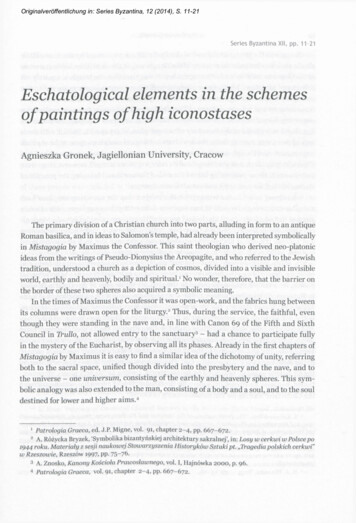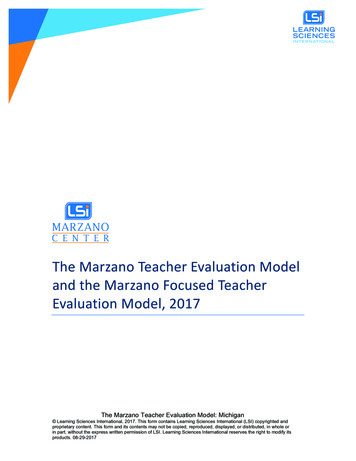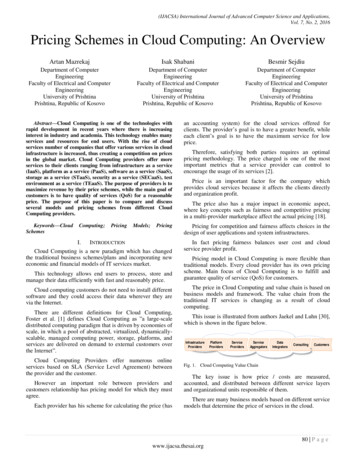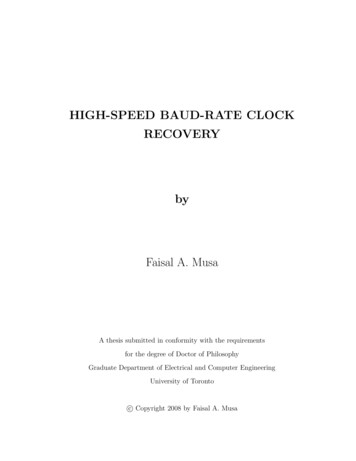
Transcription
Originalveröffentlichung in: Series Byzantina, 12 (2014), S. 11-21Series Byzantina XII, pp. 11-21Eschatological elements in the schemesofpaintings of high iconostasesAgnieszka Gronek, Jagiellonian University, CracowThe primary division of a Christian church into two parts, alluding in form to an antiqueRoman basilica, and in ideas to Salomon’s temple, had already been interpreted symbolicallyin Mistagogia by Maximus the Confessor. This saint theologian who derived neo-platonicideas from the writings of Pseudo-Dionysius the Areopagite, and who referred to the Jewishtradition, understood a church as a depiction of cosmos, divided into a visible and invisibleworld, earthly and heavenly, bodily and spiritual.1 No wonder, therefore, that the barrier onthe border of these two spheres also acquired a symbolic meaning.In the times of Maximus the Confessor it was open-work, and the fabrics hung betweenits columns were drawn open for the liturgy.2 Thus, during the service, the faithful, eventhough they were standing in the nave and, in line with Canon 69 of the Fifth and SixthCouncil in Trullo, not allowed entry to the sanctuary3 - had a chance to participate fullyin the mystery of the Eucharist, by observing all its phases. Already in the first chapters ofMistagogia by Maximus it is easy to find a similar idea of the dichotomy of unity, referringboth to the sacral space, unified though divided into the presbytery and the nave, and tothe universe - one universum, consisting of the earthly and heavenly spheres. This sym bolic analogy was also extended to the man, consisting of a body and a soul, and to the souldestined for lower and higher aims.41 Patrologia Graeca, ed. J.P. Migne, vol. 91, chapter 2-4, pp. 667-672.2 A. Rozycka Bryzek, ‘Symbolika bizantynskiej architektury sakralnej’, in: Losy w cerkwi w Polscepo1944 roku. Materialy z sesji naukowej Stowarzyszenia Historykow Sztuki pt. „Tragedia polskich cerkwi”w Rzeszowie, Rzeszow 1997, PP- 75“763 A. Znosko, Kanony Kosciola Prawoslawnego, vol. I, Hajnowka 2000, p. 96.4 Patrologia Graeca, vol. 91, chapter 2-4, pp. 667-672.
12Agnieszka GronekChanges in the liturgy at the end of the first millennium, caused by the iconoclasticshock, aimed to increase the mystery of the rituals and, at the same time, deepen a senseof God’s unattainability and non-cognisance. It was then that the templon, a purely ar chitectural structure, began to be adorned with figural representations carved in thearchitrave beam and flagstones placed on the stylobate, or with painted or mosaic pic tures hung on and between columns.5 They they primarily became the main medium forconveying deeper nuances. But even earlier the very structure of a templon, as well as thefact that it was placed at the boundary of two complementary spaces, filled it with theo logical meanings. Among them, those with eschatological meaning appear to be of primeimportance. And though over the centuries, as the area of partitions increased and wasfilled with paintings, and the liturgy and its interpretation changed, new meanings wereadded onto it, those expressing fear of the end of the world and bringing the promise ofeternal life last for centuries and even become stronger.It has been noted in the writings on this subject that the surviving templons havea similar structure and consist of four supports delineating three passages. Almost everyattempt to find a formal and ideological source of this construction leads to eschatologi cal ideas. For example, similarity has been noticed between a three-axis compositionand antique triumphal arches. The symbolism of a passage and victory encompassedby these buildings is similar to a templon leading to a space which depicts the heavenlyworld, attainable after victory over sin and death. An analogous similarity in form andcontents, derived from the function, can be seen in an extended entrance to an imperialpalace, for example the one depicted in the mosaics in the new St Apollinaris Basilicain Ravenna. This is the entrance to the sovereign’s house, just like a templon that leadsto the Kingdom of Heaven. But the strongest connection, fullest of eschatological ideas,is the one between the construction of the templon in a Christian church and the bar rier separating the Most Holy Place from the Holy Place in the Tent of Meeting (Exod26:31-33) and the Temple in Jerusalem, as well as the composition of the entrance to theTemple and the gates leading to the Holy City which simultaneously become a pictureof the New Jerusalem (Apoc 2i:io-i3).6 The Jews awaiting the Messiah, symbolised bythe tri-partite passage, separated by four supports, leading to the holy places aforemen tioned, becomes an ideological source for the construction of a templon, which expressesthe Christians’ waiting for the second coming of Christ.75 S. Kalopissi-Veri, ‘The Proskynetaria of the Templon and Narthex: Form, Imagery, Spatial Connec tion, and Reception’, in: Thresholds of the Sacred. Architectural, Art Historical, Liturgical, and Theologi cal Perspectives of Religions Screens, East and West, ed. S. E. J. Gerstel, Washington 2006, pp. 107-132.6 H. A. IIIajiHHa, ‘Bxoa “cBHTan cbhttbix” h BH3auTHHCKH ajiTapiiaa nperpafla’, in: HKonocmac.npoucxoxdenue - pa3eumue - cumboauko, ed. A. M. JIhaob, MocKBa 2000, pp. 52-84; Eadem, ‘EokoBbie BpaTa HKOHOCTaca;cHMBOJiHHecKHH 3aMHceii n HKOHorptjmn’, in: HKOHOcmac. npoucxoMdeHue.,PP- 559-598.7 H. A. mamma, ‘Bxoa ., pp. 65-66.
Eschatological elements13These most important ideas were not forgotten when pictures placed on the stone struc ture started to highlight further meanings: Christological, soteriological and Eucharistic.Eschatological messages were conveyed (including the motives of arcades and palm treesmean the victory, cypresses and ivy as the symbol of immortality8, the eagle as a symbol ofresurrection and salvation9) by the depiction of Deesis, one of the oldest depictions placedon the altar screen. It is not known exactly when it appeared here10, for centuries it consti tuted an ideological and compositional centre of iconostases, and underlined the interces sion of the Mother of God and John the Baptist for the human race with God at the time ofthe Last Judgement, and their vital role in the act of salvation.11 Primarily, this depictionhad a visionary character, and Mary and John were presented as the first and most im portant witnesses of Christ’s divinity. In this sense, Deesis co-created church decorationsuntil the 13th century. Yet simultaneously, at least from the 10th century onwards, this groupof three people was included in the templon and the scenes of the Last Judgement, wherethe idea of intercession is unequivocal and clear. It is passed on to other people who areadded to the central group as iconostasis becomes larger, with rows of a dozen or so figuresfrozen in identical praying positions. These are firstly archangels, Michael and Gabriel,apostles, Peter and Paul, evangelists, Church Fathers and other saints. Their selection wasnot strictly prescribed and it usually depended on local custom.The idea of an intercessory prayer at the Last Judgement is dominant in the schemesof high iconostases, popular in late and post-Byzantine art. They emerged at the end ofthe 14th century in northern Russia, and the one believed to be the oldest was created byTeophanes the Greek in 1399 for the Archangel Cathedral of the Moscow Kremlin, of whichonly the icons from the Deesis row remain today. After 1547 they were combined with othericons painted by Moscow masters at the beginning of the 15th century, i.e. Andrei Rublevand Daniel Cherniy, making up an iconostasis of impressive proportions in the Cathedralof the Annunciation in the Kremlin, admired to this day.12 The surviving iconostases in theCathedral of the Dormition of the Theotokos in Vladimir and in the The Trinity Lavra of St.Sergius are solely the works of Andrei Rublev and Daniil Cherny’s workshop. They are anunusual phenomenon in the world of art, culture and religion, and their creation required8 Compare for excample motives on the templon of St. Sophia in Kijv; E. ApxnnoBa, Pe3aHOu KaMeHbe apxmeKmype dpeaneso Kueea, KneB 2005, p. 235, fig. 38.9 E. D. Maguire and H. Maguire, Others Icons. Art. And Power In Byzantine Secular Culture, Princ eton 2007, pp. 58-96.10 L. Nees, ‘Program of Decorated Chancel Barriers in the Pre-lconoclastic Period’, Zeitschrift furKunstgeschichte, 46 (1983), pp. 15 26.11 About Deesis compare: Th. v. Bogyay, ‘Deesis’, in.: Reallexikon zur byzantinischen Kunst, ed. K.Wessel, M. Restle, vol. 1, Stuttgart 1966, pp. 1176-1186; A. Kazdan, ‘Deesis1, in: The Oxford Dictionary ofByzantium, vol. 1, New York 1991, P- 599 6oo; Ch. Walter, ‘Two Notes on the Deesis’, Revue des EtudesByzantines, 26 (1968), pp. 311 336; H. Madej, ‘Deesis’, in: Encyklopedia katolicka, vol. 3, Lublin 1995,pp. 1086-1088.12 JI.A. IlfeHHHKOBa,‘/tpeBHepyccKHHbmcokhhHKonocTacXlV- Havana XVb.: htoi’h h nepcneKTHBbiH3ynenHH,’ in: IlKonocmac. IlpoucxooicdeHue., pp. 392-410.
14Agnieszka GronekFig. 1. Iconostasis, Dmytrovice, Ukraine, Saint Nicholas Church, XVII c., photo by Piotr Krawiecnot only an artistic talent, deep faith and awareness of the mood of the era, but primarilydeep philosophical and theological knowledge. No wonder research is still under way todetermine the authors of the project and the circumstances and reasons for its execution.13Today, the prevalent view in Russian studies allows us to consider Theophanes the Greekand Cyprian the Metropolitan of Moscow the originators of the high iconostasis.14 AndreiRublev took over the idea, developed it artistically and brought it into general use.The essence of the new altar screen was its size and scheme of paintings. Dividedinto several rows filled with icons, it created a structure which, like a wall, fully cov ered the passage to the sanctuary. This space, completely hidden now from the eyes ofthe faithful, and liturgical rituals taking place in it, became even more mysterious andinaccessible. Thus the division of the Orthodox church into two spheres was strength ened, and the difference between the faithful in the nave and the priests who had ac13 Some Russian researchers can’t agree with thesis, that the oldest high iconostasis was created byTheofanes and consider that idea of creating ones was purely Russian not Greek, compare B. H. JIa3apeB,Teocfxm VpeKu ezo uncn/ia, MocKBa 1961, p. 94; Idem, ‘ KnBonncbn CKyjihm’ypa HoBorpoaa’, in: McmopunpyccKozo ucKyccmea, MocKBa 1954, vol. 2.1, p. 164; B. T. BprocoBa, Andpeu Py6/ien u mockorckqh uikoaciOKueonucu, MocKBa 1998, p. 21.14 JI. A. IIIeHHHKOBa, /(peenepyccKuu bucokuu ., p. 399-444; JI. M. EBceeBa, ‘ScxaTO/ioi Mii 7000rotta h B03HHKH0BeHne BbicoKoro HKOHOCTaca’, in: MicoHOcmac. [IpoiicxoAcdeiiue., p. 411-430.
Eschatological elements15Fig. 2. Iconostasis, Curtae de Arges, Romania, Saint Nicholas Royal Church, XVII c.,photo by Piotr Krawieccess to the sanctuary was deepened. This definite separation of the sanctuary fromthe rest of the Orthodox church could be conducive to ideas learnt from the writings ofMaximus the Confessor, who saw in it the depiction of the heavenly world. The reflectionof these moods, in an already mature and cogent form, combined with the symbolismof liturgy, can be found in the writings of Symeon of Thessalonica who often explainedthe division of an Orthodox church into two parts: Being divided into the Holy of Holi est and the external parts, it represents Christ himself, and his two natures: that ofGod and that of man. One is visible and the other invisible; it also [represents] Man,consisting of the soul and body. But it also perfectly [represents] the mystery of theTrinity, which is inaccessible in [its] essence, cognizable in providence and might. Andin particular it reflects the visible and invisible world, but also the visible one alone:heaven through the altar and the earthly matters through the rest of the church.15Further, as the idea of a sanctuary whose depiction of heaven appealed more and morefully to the imagination of the faithful, so was the a high iconostasis wall more andmore clearly interpreted in eschatological terms. It became an important and tangible15 Patrologia Graeca, vol. 155 PP- 7 3—7 4J pol. trans.: Symeon z Tessaloniki, O swiqtyni Bozej,trans. A. Maciejewska, Krakow 2007, pp. 38-39.
i6Agnieszka GronekFig. 3. Central part of Iconostasis, Poland, Gorajec, Nativity of Mary Church, XVIII c.,photo by Piotr Krawiecscreen covering, like a horizon, the divine world16, and at the same time giving the onlychance to go over to the other side. No wonder then, that here, in the very middle ofthe sacred paintings the depiction of Deesis dominated, expressing the idea of intercessionfor the human race at the time of the Last Judgement. The Deesis created by Theophanesthe Greek was over two metres high. Enormous and monumental, depicted against the goldbackdrop, it must have attracted people’s eyes and be the focus of prayerful requests.And, in particular, a gigantic Christ placed in the middle of the row in snow-white robes,with a benign face, raising his hand discretely in a gesture of benediction and showing inan open book a quotation from the Holy Gospel according to .John: I am the light of theworld; anyone who follows me will not be walking in the dark, but will have the lightof life (8:12). Rublev’s Christ from the Cathedral in Vladimir is even larger, over threemetres high, overwhelming in his enormousness and awe-inspiring. He is the judge atthe Last Judgement, as the verse from the Holy Gospel according to Matthew, written inthe pages of the Bible, clearly states: When the Son of man comes in his glory, escortedby all the angels, then he will take his seat on his throne of glory. (Matt 25:31). In Ru blev’s iconostases Saints Advocates placed in an extended row of the Great Deesis are16 About iconostasis such the veil compare N. P. Constas, ‘Symeon of Thessalonike and the Theologyof the Icon Screen’, in: Thresholds of the sacred., pp. 163-183.
Eschatological elements17Fig. 4. Iconostasis, Polovragi, Romania, Saint Nicholas Church, XVIII c., photo by Piotr Krawiecaccompanied by Old Testament prophets, whose full-length figures create an additional,new row. This type of iconostasis becomes most popular in northern Russia.17 In thei6'h century, at the very latest, another row appears; of Old Testament patriarchs; whichchanges the upper part of the screen into an extended numerous intercessory group,raising prayers to Christ the Judge.Researchers indicate several reasons for the emergence and then popularisation of thehigh iconostasis in the northern areas in this sort of form and with this sort of structureof the ideological schedule. Apart from the expanding hesychastic beliefs and practicesand changes in the liturgy introduced by Cyprian the Metropolitan of Moscow, fear ofthe end of the world appears to be the most convincing. Waiting for the Second Comingof Christ [parousia] became more pronounced with the approach of the year 7000 fromthe creation of the world, i.e. 1492 from the birth of Christ. The belief in the end of theworld happening then, known in the entire Byzantine world, drew a particularly strongresponse in the Muscovite Russia.18 The apocalyptic texts of the Hippolytus of Rome,17 A. MejibHHK, ‘OcHOBHbie ranbi pyccKHX bmcokhx HKOHOc-racoB XV - cepeflHHbi XVII BeKa’, in:MKOHOcmac. npoucxmtcdeuue., p. 433.18 H. A. Ka3aKOBa f. C. Jlypbe, Aumuifieoda/iuiue epemunecKue deinicemot Ha Pycu XlV-nananaXVIeexa, MocKBa 1955, p. 39V H.M. EBceeBa, ‘9cxaTOJiornfl 7000 roaa ., p. 296-297.
i8Agnieszka GronekEphrem the Syrian, Pseudo-Methodist of Pantara or Palladius the Monk were knownhere.19 The idea of the end of the world 7000 years from its creation had already arrivedhere from Byzantium in the early Middle Ages and it was known to the 12th century writ ers: Nestor, Abraham from Smolensk and Kiryk from Novogrod.20 It was also reinforcedin the 14th century by itinerant monks-hesychasts travelling from the Balkans to thenorth, and by Cyprian the Metropolitan of Moscow.21 Nature itself also strengthenedthe conviction of the approach of the Judgement Day, displaying a series of dangerousphenomena to the alarmed people, which they would dutifully record and interpret in aneschatological vein, such as the eclipse of the sun or the moon, earthquakes, droughts,fires or epidemics22. Historic events were also perceived in a similar vein, especially ofgreat importance, such as Ottoman invasions23 and the fall of Constantinople, whichdeepened the gloom of 15th century apocalyptic visions.It is worth noting that it was in the Great Entrance that Symeon of Thessalonica sawboth the depiction of Christ’s funeral and his second coming to the Last Judgement, sothe moment of transfer of the Sanctified Gifts and offering them on the altar, was, inhis opinion, filled with Passion and eschatological themes24. Therefore the dismissal ofcatechumens and then the faithful receiving the Eucharist was understood as a repre sentation of Matthew’s separating sheep from goats (Matt 25:3a)25. And all this hap pened in front of the great wall of paintings, dominated by the representation of Christthe Judge and a procession of saints, the pillars of the Orthodox church, deep in anintercessory prayer for the human race. This ingenious programme of the iconostasisfully answered the faithful’s fears of the approaching apocalypse and contributed to themystery of the liturgy which offered the prize of eternal life. It is not surprising thenthat it became popular all over Russia, Ruthenia (fig. 1) and also reached the Balkans inthe 16th century (fig. 2).19 W.Hryniewicz, Staroruska teologia paschalna w swietle pism siv. Cyryla Turowskiego, Warszawa1993 P-160; E. Przybyl, ‘Historia w cieniu czasow ostatecznych. Ewolucja idei eschatologicznych na Rusiw XI-XVII w.’, Nomos. Kwartalnik Religioznawczy, 16 (1996), p. 87.20 E. Przybyl, op. cit., pp. 88-90.21 Ibidem, p. 93; compare also J. H. Billington, Ikona i topor. Historia kultury rosyjskiej, Krakow2008, p. 51.22 In homilie of Serapiona from Volodimir, compare G. Podskalsky, Chrzescijahstwo i literatura teologiczna na Rusi Kijowskiej {988-1237), Krakow 2000, p. 151; W. Hryniewicz, op. cit, p. 160; E. Przybyl,op. cit., p. 93.23 G. Podskalsky, op. cit., pp. 118-121.24 Patrologia Graeca, vol. 155, pp. 727-728; H. Wybrew, The Orthodox Liturgy. The Developmant ofthe Eucharistic Liturgy in the Byzantine Rite, New York 1996, p. 164; it. IHyjibn RisamniucbKa nimypzisi.CeidnenHS eipu ma suaHenuusi cumboaw, JI bai b 2002, p. 199; R. Taft The Great Entrance. A History ofthe Transfer of Gifts and other Pre-anaphral Rites, Roma 2004, pp. 210-213. Cf. Symeon z Tessaloniki,op. cit., p. 70.25 Patrologia Graeca, vol. 155, pp. 293-294.
Eschatological elements19Fig. 5. Deesis Row in Iconostasis, Bartne, Poland, Cosmas and Damian Church, XVIII c.,photo by Piotr KrawiecThe earliest evidence of the presence of high altar screens in the areas which are nowpart of Ukraine comes from the 16th century. We know of the last will and testament ofBazyli Zagorovsky from 1577 in which he obliged his beneficiaries to furnish the Ortho dox Church of Ascension in Suchodoly in Volhynia with ‘paintings, Deesis as well as sov ereign, feasts and prophets icons, so that they are beautifully painted to meet the needsand the order of services of our Christian Orthodox church”26. But the Deesis group couldalso be found earlier in lower iconostases. The Pechersk-Kiev Paterick includes a story of‘another man, Christ-lover from the same town of Kiev, built an Orthodox church for him self and decided to decorate it with large icons: five Deesis and two sovereign . [so] hegave silver to two monks in the Pechersk monastery to come to an agreement with Alimpito pay him as much as he wanted for the icons’.27 This note undoubtedly confirms an earlyformation of a two-tier iconostasis with the Deesis group and a row of sovereign icons.This is also confirmed by later, 15th-century icons of Christ, the Mother of God, very26 Apxue lOzoSanadnou Poccuu, KhIb 1859, vol. 1, part. 1, p. 797; compare also: C. TapanyuieuKOyKpaiHCbKHH iKOHOCTac’, 3anuaai Ilayxofiozo Toeapucmea mem T. UleeneHKa, 217 (1994) p 15027 Pateryk Kijowsko-Pieczerski czyli opowiesc o swi?tych ojcach w pieczarach kijowskich poloionycn, trans. L. Nodzynska, Wroclaw 1993, p. 249.
20Agnieszka Gronekpopular saints and extended Deesis groups28. Furtermore the analysis of later historicmonuments and source documents confirms that the theme of Deesis was very importantin the painting schemes of iconostases.In the inspection documents from Greek Catholic Orthodox churches one of the mainquestions on the decor refers to Deesis29, and though today it is not certain whether thisterm always refers to the iconographic theme, or rather, to the iconostasis itself, it isthe fact of equating Deesis with the altar screen that indicates its importance and beingestablished in the painting tradition and the faithful’s awareness. In northern RussianDeeses Christ is depicted in an extended iconographic type known as Maiestas Domini(Rus. Spas w sylakh). This depiction came to the Ruthenia (Ukraine) in the 15th century,but rarely constituted the centre of Deesis, and was more frequently included in the sov ereign row30. This departure from the original premises of the creators of high iconos tasis, consciously or not, strengthened eschatological ideas and expanded them to thelower row as well. Christ in Majesty depicted here is holding the Bible, often open on thefollowing quotation: Come, you whom my Father has blessed, take as your heritage thekingdom prepared for you since the foundation of the world (Matt 25:34) describing theLast Judgement, so he is not a teacher here, but a judge. A similar effect is achieved byplacing in the Sovereign row not icons but the depiction of Christ Pantocrator, extendedto include smaller figures of the Mother of God and John the Baptist, which repeated theDeesis theme from the row above.Perceiving the altar screen as a curtain to paradise is also confirmed by later, mostly 18thcentury, decoration of the Deacons’ doors, on which Archangels Michael and Gabriel wereplaced, a direct reference to the words from the Book of Genesis: He banished the man, andin front of the garden ofEden he posted the great winged creatures and the fiery flashingsword, to guard the way to the tree of life (Gen. 3:24). Examples of such an approach can befound in iconostases in the Birth of Christ Orthodox Church in Zhovkva, in Bohorodchany,Cathedral of the Dormition in Pechersk Lavra, Gorajec (fig. 3) and Chotyniec.In the Balkans there are however iconostases where the Deesis row is replaced withrepresentations of Christ with the apostles, and thus the eschatological meaning of thescreen has been lost (fig. 4). But not always, as sometimes the apostles are sitting withopen books, for example in St Nicholas Orthodox Church in Hunedoara31, in the orthodox28 W. Jarema, ‘Pierwotne ikonostasy w drewnianych cerkwiach na Podkarpaciuj Materialy MuzeumBudownictwa Ludowego w Sanoku, 16 (1972), pp. 22-32; C. TapaiiymeiiKO, op. cit., p. 150.29 Recently about this subject: M.P. Kruk, ‘.Deisus dawn;} zwyczajn;) robotq y malowaniem” - kilkauwag na marginesie inwentarzy cerkiewnych’, in: Ars Graeca Ars Latina. Studia dedykowane ProfesorAnnie Rozyckej Bryzek, Krakow 2001, pp. 207-230.30 M. I’exHTOBHH, YnpaiHChKi iKOHU „Cnacy y Cnaei, Jlbiiiii 2005, p. 5.31 M. Porumb, Dictionar de pictura veche Romaneasca din rrransilvania sec. XIII-XVIII, Bucure ti1998, pp. 162-167; A. Efremov, Icoane romane ti, Bucare§ti 2002, pp. 9, 56,172.
Eschatological elements21church in Vanatori-Nemet or in the monastery museum in Varatec32; or with closed booksin Filipesti de Padure. Usually the apostles sit in God’s presence in the depictions of theLast Judgement. They are the only ones, as promised by God, to be awarded this honour(Matt 19:26, Luke 22:30). Their main attributes are scrolls and codices - symbols of wis dom, bequeathed by Christ. They should be closed, as the Church’s mission has not beenaccomplished yet, and the full mystery of the Incarnation of God’s Son will be revealed atthe end of the world. Therefore the books will be open at the Last Judgement. Thereby, thesitting position of the apostles in Christ’s presence and their open books may be interpret ed in the eschatological context, and this depiction may still illustrate the Last Judgement,but without the reassuring presence of influential intercessors.It is difficult to pinpoint a particular reason for these changes today. In Ukrainianiconostases, for example, from the end of the i8lh century, Christ in priest’s robes issitting in the middle of the Deesis row (fig. 5). He is no longer a judge in white robes,as Theophanes the Greek envisaged, but the highest priest celebrating the Liturgy. Es chatological ideas have been dominated by Eucharistic and ecclesial ones. The Motherof God and John the Baptist are no longer depicted in an intercessory stance, typical ofOrthodox art, but in one of adoration and worship. And the apostles, rather than prayingwith their hands outstretched, are holding the tools of passion and death in them. Thefall of Constantinople, distance from the main centres of Orthodox culture, occidentalisation and Latinisation of orthodox church art, plus a low level of education of easternpriests - all these factors must have contributed to the departure from traditional mod els, presumably no longer intelligible. Perhaps changes in the civilisation made it pos sible to treat apocalyptic visions as one of the great myths of culture and religion, whichis also characteristic of our times?Translated by Malgorzata Strona32 V. Dragut, Arta Romaneasca, Bucare§ti 2000, p. 318.
the rest of the Orthodox church could be conducive to ideas learnt from the writings of Maximus the Confessor, who saw in it the depiction of the heavenly world. The reflection of these moods, in an already mature and cogent form, combined with the symbolism of liturgy, can be found in the writin










